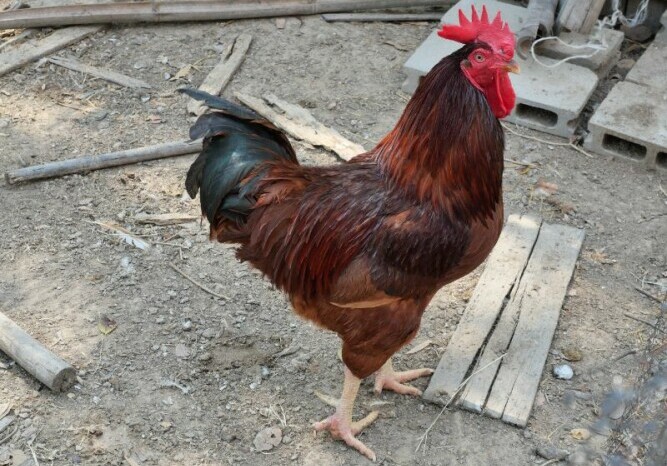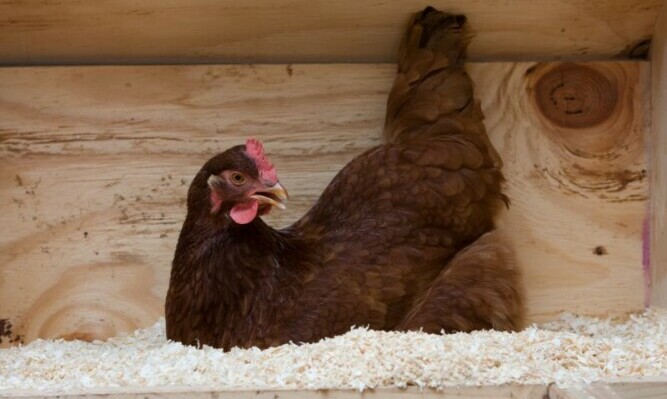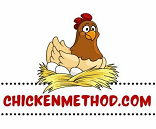
I’m moving on to one of the most famous chickens in the land next to Foghorn Leghorn: the Rhode Island Red. This article is about their striking appearance, versatility, and enduring popularity among flock tenders and commercial farmers. Follow along to understand the top attributes that make Rhode Island Reds so sought after.
Rhode Island Reds stand out for their deep, rich red feathers, ranging from a rust-colored shade to a near black in some birds.
Their sturdy build and broad feathers speak of resilience, while their alert and bright red-orange eyes reveal a bird ready to take on anything.
Their medium-sized, red earlobes and wattles complement the bold coloring of their feathers, making them a functional addition to your farm and a visually appealing one.
One of the reasons why these birds are so admired is their adaptability. Whether they’re scratching around a snowy coop amid winter or foraging beneath the baking summer sun, Rhode Island Reds thrive.
They are a tough breed, equipped to handle a variety of climates, a trait that makes them a practical choice for many.
While many Rhode Island Reds are known to be friendly creatures, often getting along well with other chickens, they can be pretty cranky (so I’ve read).
Now, how did these birds become such a staple on the farm? Please stick with me, and you’ll learn about the history that has shaped the Rhode Island Red into the resilient, productive bird it is today.
Origin of Rhode Island Reds

I will take you back in time to uncover the origins of the Rhode Island Red. This breed didn’t just appear out of thin air. It resulted from careful breeding and the ingenuity of early American farmers.
The story begins in the mid-19th century in the New England state of Rhode Island, hence the name.
That’s where we find poultry breeders crossing various birds like the Malay, Cochin, and Leghorn to create a chicken that could withstand the harsh climates of the northeast U.S. and still produce a remarkable number of eggs.
The development and spread of this breed, from its small-town roots to farms around the globe, is quite the tale of success.
What’s often understated is the impact of the breed’s origin on its present-day characteristics. The Rhode Island Red’s ancestors were chosen for their ability to survive, which is why today’s birds are known for their hardiness and productivity—a direct link to their lineage.
Eggs, Meat, and Beyond
The debate often rages among poultry fans about whether a breed excels as a layer or meat producer, but Rhode Island Red owners quickly note that these birds don’t force you to choose.
Let’s start by looking at their chops as layers. Rhode Island Reds are very good layers known to reliably produce many eggs. Hens comfortably lay between 200 and 300 large, brown eggs per year.
That’s a lot of breakfasts and bakes taken care of! This prolific laying capability ensures they’re a favorite among backyard flock owners and commercial farmers.
But what about when it’s time for Sunday dinner? These birds also possess commendable qualities as meat producers.
With their large frame, they provide a generous amount of meat, which is known for its flavor and quality.
Their dual-purpose nature hasn’t just stumbled upon the farming scene by accident. Instead, it’s the result of careful selective breeding over the years.
Breeders have honed in on maximizing these characteristics, so choosing a Rhode Island Red means you have a hard-working member in your coop—whether you’re hankering for fresh eggs or homegrown chicken on the dinner plate.
Physical and Behavioral Traits of Rhode Island Reds

I’m going to kick things off by talking about weight. A full-grown Rhode Island Red rooster typically tips the scales at 8.5 pounds, while hens weigh 6.5 pounds.
But size isn’t all; body composition plays a part in cold weather resistance, and these chickens are well-equipped with a broad, deep body.
How do they fare in extreme weather?
Remarkably well!
Rhode Island Reds have a thick feathering that gives them an edge in cold climates, making them cold-hardy. But what about heat?
Despite their heavy set, they can manage quite well in warmer conditions, although ample shade and water are a must as they can be prone to overheating.
In my opinion, temperament is a crucial factor in choosing a chicken breed, and Rhode Island Reds tend to be calm and friendly.
Although they can be a bit aloof, they generally get along well in a mixed flock and are not known to be aggressive. It makes them excellent for families and interactive farmyards.
On to foraging – choose a Rhode Island Red if you want a hen to seek food actively.
They are great foragers, which is fantastic for pest control and can help lower the feed bills. Moreover, their foraging skill shows their intelligence and adaptability, making them even more appealing.
Celebrating Rhode Island Reds
I hope that you’ve gained a deep appreciation of Rhode Island Red chicken through this exploration.
Now that you have learned about their temperament, hardiness, foraging skills, and health needs, you can see why Rhode Island Reds are highly regarded among poultry enthusiasts and farmers alike.
They offer a fantastic balance of characteristics that can enrich any homestead or commercial operation, backyard, and farm; it’s also an invitation for you to consider what Rhode Island Reds could bring to your flock.
A lot happens quickly in poultry breeding, but the Rhode Island Red stands strong as a constant.
I’d love to hear your feedback or any experiences you’ve had with Rhode Island Reds. Have they lived up to their reputation? Whatever your story, remember that your first attempt at poultry keeping doesn’t need to be your last. With breeds like the Rhode Island Red, you can always adjust your approach, ensuring a bountiful coop for years to come.
Thanks for reading, and take good care of yourself.
Dave
Chickenmethod.com
